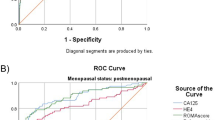Abstract
Purpose
To investigate whether the activity of lysosomal enzymes is increased in the peritoneal fluid of patients with gynecologic cancers compared to activity in the peritoneal fluid from normal subjects and those with pelvic inflammatory disease, and fluid from benign ovarian cysts.
Patients and methods
β-glucuronidase, β-galactosidase, and α-mannosidase activity was measured in the peritoneal fluid from patients with gynecologic cancer, pelvic inflammatory disease, and normal subjects, and fluid from benign ovarian cysts.
Results
The mean±SD of β-glucuronidase, β-galactosidase, and α-mannosidase activity in the gynecologic cancers was 120±50 nmol, 203±86 nmol, and 240±119 nmol 4-methylumbelliferone/ml/h, respectively; in the normal control subjects it was 22±9 nmol, 46±10 nmol, and 80±23 nmol, respectively (P=0.00003, 0.0001, and 0.0001, respectively). The activity was increased even in cases without malignant cells in the peritoneal fluid. In pelvic inflammatory disease it was 148±82 nmol, 278±112 nmol, and 291±140 nmol, respectively. The activity in the fluid of the ovarian cysts was similar to that of the normal peritoneal fluid. There was a significant positive correlation between enzyme activity and stage of cancer, that was stronger for β-glucuronidase (r=0.889, P=0.003).
Conclusion
The increased lysosomal enzyme activity in gynecologic cancers, without overlapping between patients and normal subjects or benign ovarian cyst fluid, indicates that such measurements might be applied for diagnostic purposes.

Similar content being viewed by others
References
Beratis NG, Mavrommatis T, Hatiris I, Kavaliotis J, Tsagaropoulou-Stiga H, Syrogiannopoulos GA (1997) Increased activity of lysosomal acid hydrolases in the cell-free cerebrospinal fluid of bacterial meningitis. Pediatr Res 41:235–241
Beratis NG, Georgiou G, Eliopoulou M (2002) Increased activity of lysosomal enzymes in the peritoneal fluid of bacterial peritonitis. Pediatrics 109:E44
Beratis NG, Eliopoulou MI, Syrogiannopoulos GA (2003) β-Glucuronidase in the diagnosis of bacterial meningitis and responce to treatment. Acta Paediatr 92:1272–1276
Berchem G, Glondu M, Gleizes M, Brouillet JP, Vignon F, Garcia M, Liaudet-Coopman E (2002) Cathepsin-D affects multiple tumor progression steps in vivo: proliferation, angiogenesis and apoptosis. Oncogene 21:5951–5955
Erickson AH, Blobel G (1979) Early events in the biosynthesis of the lysosomal enzyme cathepsin D. J Biol Chem 254:11771–11774
International Federation of Gynecology and Obstetrics (1991) Annual report on the results of treatment in gynecological cancer. Int J Gynecol Obstet: 36[Supp]:132–240
Kornfeld S (1986) Trafficking of lysosomal enzymes in normal and disease states. J Clin Invest 77:1–6
Lösch A, Schindl M, Kohlberger P, Lahodny J, Breitenecker G, Horvat R, Birner P (2004) Cathepsin D in ovarian cancer: prognostic value and correlation with p53 expression and microvessel density. Gynecol Oncol. 92:545–552.
Mathieu M, Rochefort H, Barenton B, Prébois C, Vignon F (1990) Interactions of cathepsin-D and insulin-like growth factor-II (IGF-II) on the IGF-II/mannose-6-phosphate receptor in human breast cancer cells and possible consequences on mitogenic activity of IGF-II. Mol Endocrinol 4:1327-1335
Mikkelsen T, Yan PS, Ho KL, Sameni M, Sloane BF, Rosenblum ML (1995) Immunolocalization of cathepsin B in human glioma: implications for tumor invasion and angiogenesis. J Neurosurg 83:285-290
Proia RL, Neufeld EF (1982) Synthesis of β-hexosaminidase in cell-free translation and in intact fibroblasts: an insoluble precursor α chain in a rare form of Tay-Sachs disease. Proc Natl Acad Sci USA 79:6360–6364
Rosenfeld MG, Kreibich G, Popov D, Kato K, Sabatini DD (1982) Biosynthesis of lysosomal hydrolyses: their synthesis in bound polysomes and the role of co- and post-translational processing in determining their subcellular distribution. J Cell Biol 93:135–143
Vetvicka V, Vetvickova J, Hilgert I, Voburka Z, Fusek M (1997) Analysis of the interaction of procathepsin D activation peptide with breast cancer cells. Int J Cancer 73:403–409
Vlacha V, Eliopoulou M, Haidas S, Beratis NG (2004) Correlation of cerebrospinal fluid β-glucuronidase activity with plasma methotrexate concentrations in leukemic children receiving high dose methotrexate. Pediatr Blood Cancer 42:350–356
Vladutiu GD, Rattazzi M (1979) Excretion-reuptake route of β-hexosaminidase in normal and I-cell disease cultured fibroblasts. J Clin Invest 63:595–601
Author information
Authors and Affiliations
Corresponding author
Rights and permissions
About this article
Cite this article
Beratis, N.G., Kaperonis, A., Eliopoulou, M.I. et al. Increased activity of lysosomal enzymes in the peritoneal fluid of patients with gynecologic cancers and pelvic inflammatory disease. J Cancer Res Clin Oncol 131, 371–376 (2005). https://doi.org/10.1007/s00432-004-0649-5
Received:
Accepted:
Published:
Issue Date:
DOI: https://doi.org/10.1007/s00432-004-0649-5




